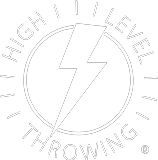The "Water Bottle" Drill teaches an athlete to develop high level throwing patterns via motor learning. Positions cannot be taught in a throw. Movements need to be the focus. This is why the "L" Drill is so detrimental for baseball & softball players, where a specific position is the focus and not the actual movement through that position.
The two videos below are comparison throws with the first video being the "L" Drill and the second one is the High Level Throwing® Pattern using the water bottle. There's a significant difference between the two. Do you see it?
L Drill Technique
The "L" drill throw is used by almost every coach and pitching instructor out there and honestly, I'm tired of seeing it.
In video 1, you cannot create resistance in a throw. In this drill, the arm supplies the force and not the entire body due to the position of the elbow and the "pushing motion" it creates. This places tremendous stress/force distribution on the shoulder and elbow due to a lack of separation between the hips and trunk and does not disperse the energy optimally!
The elbow does not unhinge, unravel or extend near the body and as the trunk becomes flexed, as where it should. Instead, it moves forward past the body significantly, creating a pushing motion. The elbow is out in front of the body and energy transfer and utilization has been lost.
Water Bottle Technique
The second video shows High Level Throwing® Patterns in which the arm starts down by the side, the stride is initiated, the trunk turns back against the hips and the hips open up towards ball release.
With this proper arm pattern and hip to trunk relationship, the body now has the ABILITY to create resistance in a throw. This is shown using the water bottle. As the water shifts in the bottle, it allows an athlete to feel the resistance created by the body.
As the lead leg is about to land, the arm is moving through its pattern and moving through external rotation towards ball release. The elbow must unhinge or extend near the head or body without drifting forward. When this happens, the proper timing of pronation can occur through ball release.

